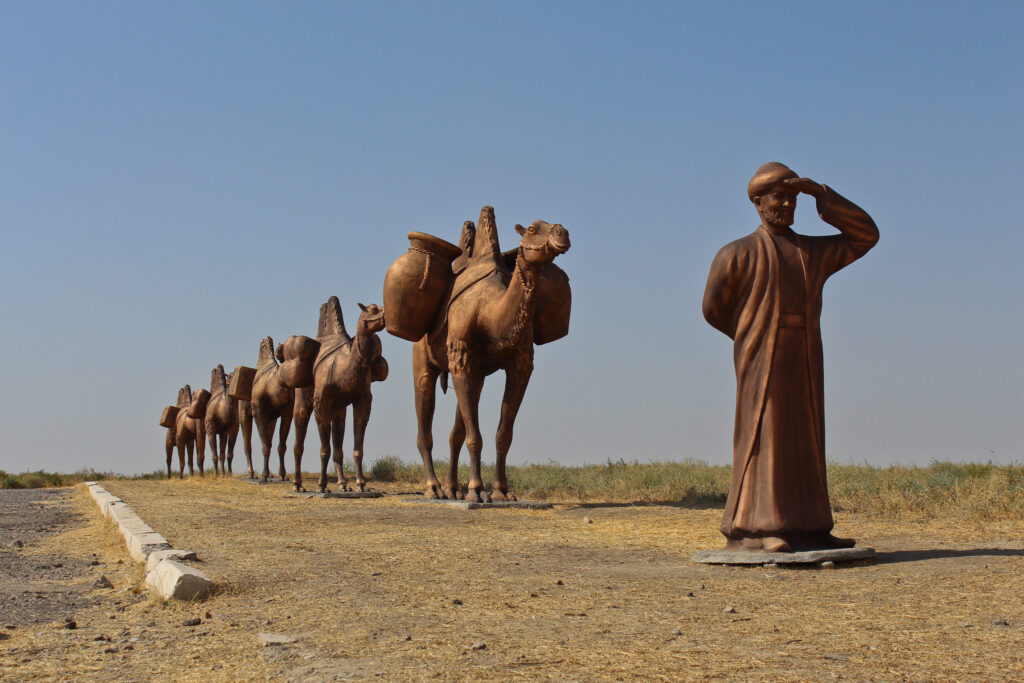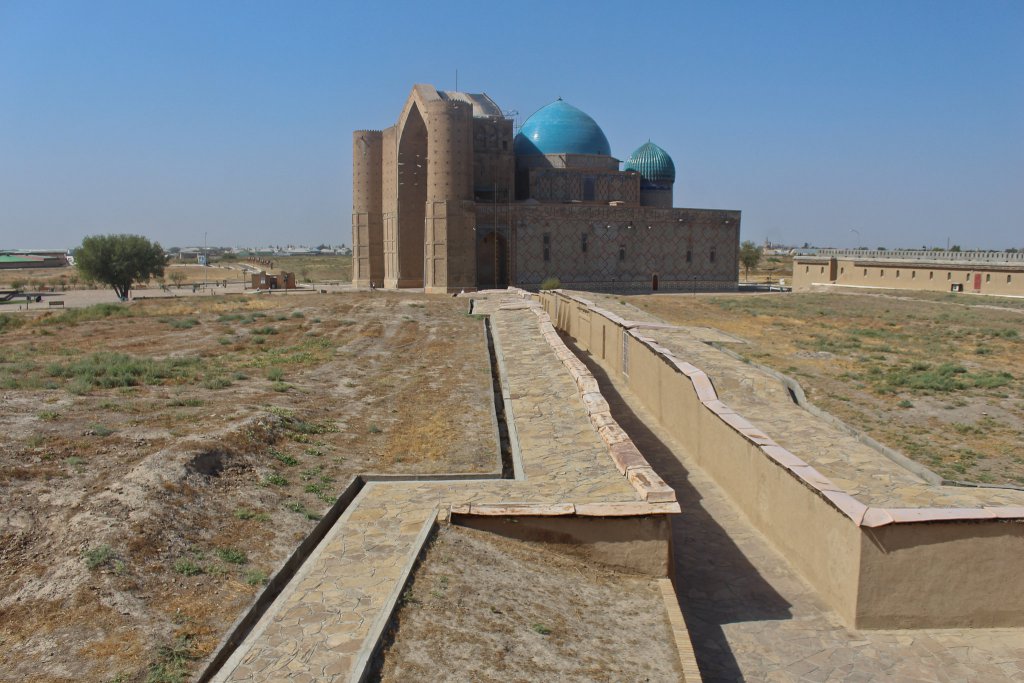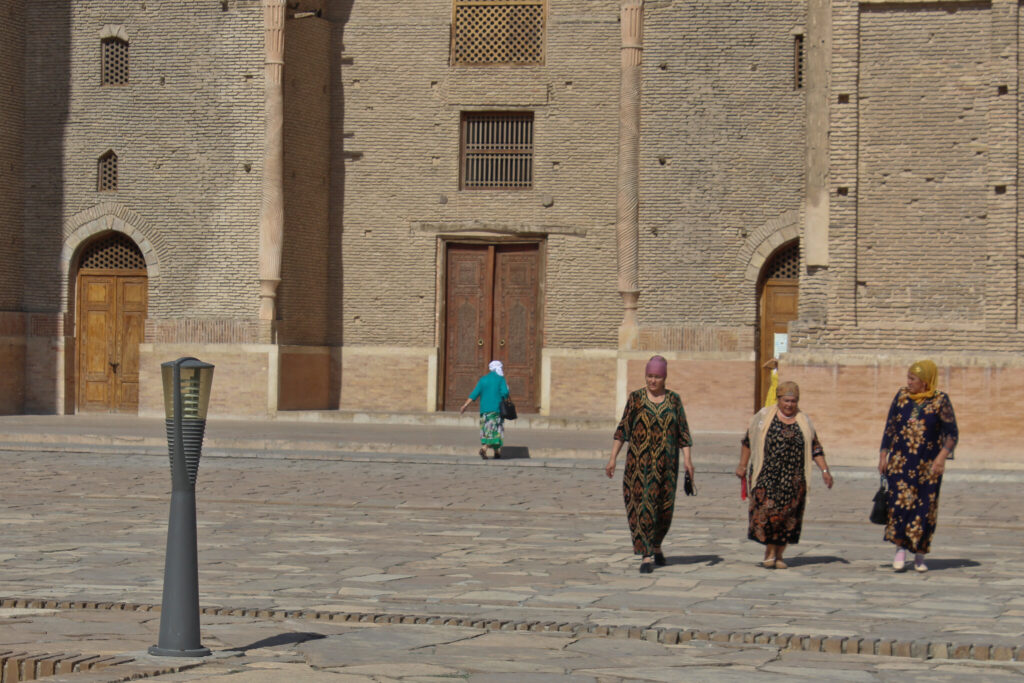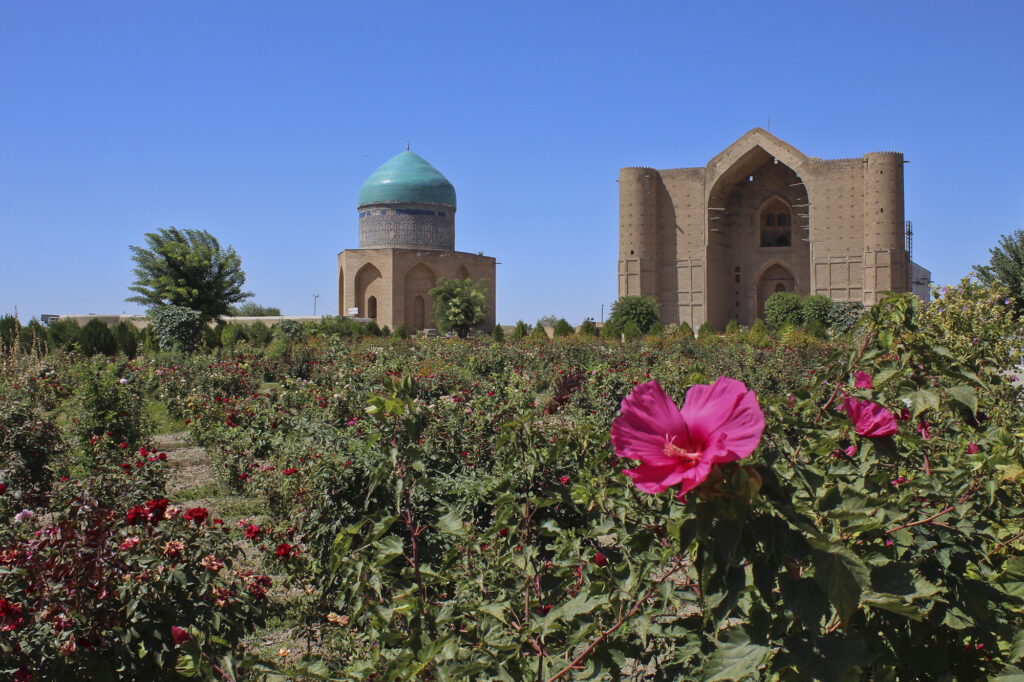Turkistan – Kazakhstan’s pearl on the silk way
Take a tour to Turkistan with us to have a look on the Mausoleum of the Turkic poet and Sufi Khoja Ahmed Yasawi.
We started our journey on a saturday autumn morning in Shymkent and went by Mini bus on the motorway M32 to Turkistan – the capital of the region with the same name.
The busy motorway M32 filled with trucks is the new silk way between Asia and Europe and follows on the same track like the old silk road with their caravans does.

On the right we had a nice view to the Karatau mountains and to the left the still green and yellow fields of the Kazakh steppe.
After the two hour ride, with approximately 170 kilometers on the motorway, we arrived the city centre of Turkistan.
Turkistan is a old caravansary of the ancient silk road and was founded in the 4th century. Long time it was a non-important city in the shadow of the more popular city Otrar. The city Turkistan got with the name Shavgar more notoriety and was growing very fast. Today the city has around 230 thousand inhabitants.

We left our mini bus in the city center at the Amir Timur street close to the interesting museum Historical and cultural ethnographic center. This museum offers very much interesting items of Kazakhstan’s history. But we will visit it later. In the distance we already see a giant cyan blue dome. This is our real destination for today. But first we crossing the old city walls of Turkistan.
Two old warrior statues of the Timurlane empire are kind today and we can enter the historical center of Turkistan. A wonderful view is opening for us and we can have a view to Kazakhstan’s perl of the silk road – the Mausoleum of the Turkic poet and Sufi Khoja Ahmed Yasawi.

But who is the person for whom they built the mausoleum? His name is Khoja Ahmed Yasawi. He who was born in Sairam – now a suburb of Shymkent – in 1093. His parents was already legendary during his lifetime and also their mausoleums are visited by many pilgrims in Sairam every year. When Ahmed Yasawi was grown up he lived in Turkistan. During his life time the city was called Iasy. Yasawi wrote very much poets and influenced turk poems till today. He was a wise man and his wisdom became popular. So he taught his students in Sufism, Mystic and Islamic religion. In his last 10 years of his life he became a hermit and lived underground and died in 1166.

We arrived the entrance of the Mausoleum. It is so huge. It’s hard to look up to the top. So, who built this magnificent building? Over 200 years later the famous Kazakh king Amir Timur – or also known as Tamerlane – got inspiration out of Ahmed Yasawi’s work and he wanted to built a huge mausoleum for him. But during the beginning of the construction he experienced very much difficulities and a dream at night changed his plans. In his dream he got the task to build at first a mausoleum for the famous Kazakh wise and mystic man Arystan Bab – otherwise his work to build a mausoleum for Yasawi will be not successful. Arystan Bab was the teacher of Ahmed Yasawi. So at first Tamerlane built a Mausoleum for Arystan Bab near the ancient silk road city Otrar – just 60 kilometers south of Turkistan.
But in 1389 King Amir Timur started finally to build the new mausoleum in Turkistan for Yasawi. He also worked by his own on the design of the Mausoleum. His workers – some were the best masons from Iran – started to erected a magnificent domed landmark on his tomb.
Our eyes discovered some wooden beams in the wall of the front portal. It looks like it was scaffolding for the construction. But why is it still visible?

The project experienced a unexpected fast halt. Tamerlane died suddenly in 1405 in Otrar during his war campaign against China. With the lost of the construction owner the building remained unfinished – but it became the prototype of the Timurid Architecture.
We just recognized it during our walk around the Mausoleum. The style of the big front side and the beautiful black and cyan ornaments made by glazed ceramic tiles on the other sides you can see very often in Central Asia: for example at Amir Timur’s mausoleum (Gur-E-Emir Mausoleum), the Bibi Khanym Mosque and the Registan complex in Samarkand. But the dome of Khoja Ahmed Yasawi’s mausoleum still remains the largest dome in Central Asia. And the building is still the most significant architectural monument in the Republic of Kazakhstan. The building received the biggest award and attention when it was added to the UNESCO World Heritage list in 2003.

During our walk around the mausoleum we saw very much pilgrims who touched the walls and walked around the building, too. The mausoleum is still a very important religious site. And according to a regional tradition, doing a pilgrimage to Turkistan three times and surrounding the mausoleum is equivalent to one hajj to Mecca in Saudi Arabia. Because of the importance of Yasawi in the Islamic World the city is also known as the Second Mecca of the East.

After we finished our walk around the Mausoleum, we went inside of the building. It’s worth to do this. Unfortunatly it’s forbidden to make photos. The huge dome covers the main room – the Kazandyk. The view up to the dome is fantastic but also the bronze cauldron named Tai Kazan is a eyecatcher. With a diameter of 2.2 meters and weight of 2 tonnes it’s the largest water bowl throughout the eastern Muslim world. The Tai Kazan was made with a alloy of seven metals in 1399.

In the center – just under the two small domes of the Mausoleum – we found the Sarcophagus of Khoja Ahmed Yasawi. Pilgrims praying in front of the room usally. In the other rooms we found the palace rooms and tombs of the Kazakh Khans. They used the mausoleum also as there palace during the 16th till 18th century.
After we left the Mausoleum we went back to the Amir Timur Street and catched a Mini bus back to Shymkent. It was great to visit this masterpiece of the Timurid Architecture and to learn more about Kazakhstan’s history.
More information: https://en.wikipedia.org/wiki/Mausoleum_of_Khoja_Ahmed_Yasawi



